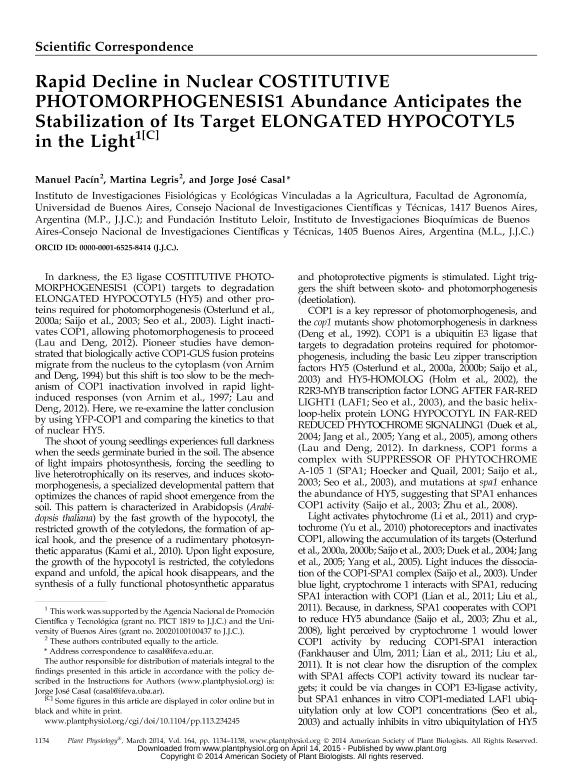Mostrar el registro sencillo del ítem
dc.contributor.author
Pacín, Manuel

dc.contributor.author
Legris, Martina

dc.contributor.author
Casal, Jorge Jose

dc.date.available
2017-06-02T21:29:17Z
dc.date.issued
2014-01
dc.identifier.citation
Pacín, Manuel; Legris, Martina; Casal, Jorge Jose; Rapid decline in nuclear costitutive Photomorphogenesis1 abundance anticipates the stabilization of its target elongated Hypocotyl5 in the light; American Society Of Plant Biologist; Plant Physiology; 164; 3; 1-2014; 1134-1138
dc.identifier.issn
0032-0889
dc.identifier.uri
http://hdl.handle.net/11336/17449
dc.description.abstract
In darkness, the E3 ligase COSTITUTIVE PHOTOMORPHOGENESIS1 (COP1) targets to degradation ELONGATED HYPOCOTYL5 (HY5) and other proteins required for photomorphogenesis (Osterlund et al., 2000a; Saijo et al., 2003; Seo et al., 2003). Light inactivates COP1, allowing photomorphogenesis to proceed (Lau and Deng, 2012). Pioneer studies have demonstrated that biologically active COP1-GUS fusion proteins migrate from the nucleus to the cytoplasm (von Arnim and Deng, 1994) but this shift is too slow to be the mechanism of COP1 inactivation involved in rapid lightinduced responses (von Arnim et al., 1997; Lau and Deng, 2012). Here, we re-examine the latter conclusion by using YFP-COP1 and comparing the kinetics to that of nuclear HY5.
dc.format
application/pdf
dc.language.iso
eng
dc.publisher
American Society Of Plant Biologist

dc.rights
info:eu-repo/semantics/openAccess
dc.rights.uri
https://creativecommons.org/licenses/by-nc-sa/2.5/ar/
dc.subject
Constitutive Photomorphogenesis 1
dc.subject
Cop1
dc.subject
E3 Ligase
dc.subject
Light
dc.subject.classification
Bioquímica y Biología Molecular

dc.subject.classification
Ciencias Biológicas

dc.subject.classification
CIENCIAS NATURALES Y EXACTAS

dc.title
Rapid decline in nuclear costitutive Photomorphogenesis1 abundance anticipates the stabilization of its target elongated Hypocotyl5 in the light
dc.type
info:eu-repo/semantics/article
dc.type
info:ar-repo/semantics/artículo
dc.type
info:eu-repo/semantics/publishedVersion
dc.date.updated
2017-06-02T17:32:11Z
dc.journal.volume
164
dc.journal.number
3
dc.journal.pagination
1134-1138
dc.journal.pais
Estados Unidos

dc.description.fil
Fil: Pacín, Manuel. Consejo Nacional de Investigaciones Científicas y Técnicas. Oficina de Coordinación Administrativa Parque Centenario. Instituto de Investigaciones Fisiológicas y Ecológicas Vinculadas a la Agricultura. Universidad de Buenos Aires. Facultad de Agronomía. Instituto de Investigaciones Fisiológicas y Ecológicas Vinculadas a la Agricultura; Argentina
dc.description.fil
Fil: Legris, Martina. Consejo Nacional de Investigaciones Científicas y Técnicas. Oficina de Coordinación Administrativa Parque Centenario. Instituto de Investigaciones Bioquímicas de Buenos Aires. Fundación Instituto Leloir. Instituto de Investigaciones Bioquímicas de Buenos Aires; Argentina
dc.description.fil
Fil: Casal, Jorge Jose. Consejo Nacional de Investigaciones Científicas y Técnicas. Oficina de Coordinación Administrativa Parque Centenario. Instituto de Investigaciones Fisiológicas y Ecológicas Vinculadas a la Agricultura. Universidad de Buenos Aires. Facultad de Agronomía. Instituto de Investigaciones Fisiológicas y Ecológicas Vinculadas a la Agricultura; Argentina
dc.journal.title
Plant Physiology

dc.relation.alternativeid
info:eu-repo/semantics/altIdentifier/doi/http://dx.doi.org/10.1104/pp.113.234245
dc.relation.alternativeid
info:eu-repo/semantics/altIdentifier/url/http://www.plantphysiol.org/content/164/3/1134
Archivos asociados
